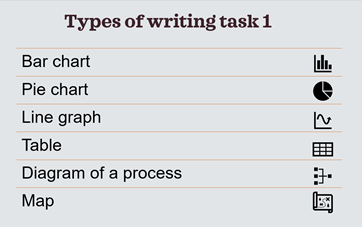This is the part of the test that most people have difficulty with. While the overall average score worldwide falls around 6, it is lower for writing, at around 5.5. Across most nationalities, writing is usually the lowest score compared to the other skills. That’s likely because most of us are not used to writing academic texts. To make sure that you are well prepared for this part of the test, it is important to understand what is required from each of the writing tasks. Then, there are different ways to practise for them and develop your academic writing skills.
There are two tasks in the writing test. Writing task 1 is a report. It will ask you to describe a visual (diagram, chart, graph, etc). Writing task 2 is an essay. It will ask you to share your opinion about a particular topic. You will have 1 hour to complete both tasks. Here is a breakdown of the difference between the two tasks:
| Writing Task 1 | Writing Task 2 |
| Time: 20 minutes Length: 150 words Type: report Description: you will be asked to describe some visual information (a chart, a diagram, etc) | Time: 40 minutes Length: 250 words Type: essay Description: you will read about a point of view, a situation or a problem and be asked to share your opinion. |
The number of words shown are the minimum required. There is no upper limit, only a time limit.
Writing Task 1
In writing task 1, you should write at least 150 words. It is recommended that you spend 20 minutes on this task. You will receive a visual to describe, this could be a chart, a graph, a diagram or a map. What is important to remember is that, in this task, you are only meant to describe the image, nothing else. You should not share your opinion or infer from the visual using your own knowledge. This task demonstrates your ability to write reports in English. See below the different types of visuals you may find in a writing task 1:

Charts and Tables
The first thing you need to determine when you see a chart or a table, is whether they show a trend. If they show a time period (years, months, etc), it’s probably showing a trend: how something has changed over a period of time. If they do not, the chart is probably not about a trend, and it’s only comparing categories.
Trend Charts and Tables
For this type of chart or table, you will need to use vocabulary that describes trends: increase, drop, soar, plummet, etc… You may also use adjectives and adverbs that describe how much things have changed during the time shown: sharp climb, fell slightly, etc…
Category Charts and Tables
For these, you will probably use language to make comparisons: comparative and superlative adjectives, vocabulary to describe and compare quantities, etc. These might have percentages or amounts. For percentages, use the words: percentage, proportion. For amounts, use the words: number, amount, quantity.
Line Graphs and Pie Charts
Line graphs normally show trends. Pie charts normally show categories in percentages. Pie charts will only show a trend if there is more than 1 chart, each representing a different time.
Diagrams
Diagrams show a process. There are different ways of describing a process, but it is very common to use the passive voice in these tasks, because it is not important who is doing the action. It is also important to describe the different steps of the process in order, or your writing may become confusing. Sequencing words can make your process description a lot clearer, too: firstly, secondly, then, finally, etc…
Maps
Maps are less common in the test, but they do appear sometimes. They show changes that have happened, or will happen, to an area. You must describe these changes using vocabulary related to transformation in places: replace, rebuild, expand, etc… The passive voice is also very important here because we do not know who is doing the changes.
Writing Task 2
For the writing task 2, you are expected to write an essay of at least 250 words. There are different types of essays:
- To what extent do you agree or disagree
- Advantages and disadvantages
- Positive or negative
- Cause and consequence
- Cause and solution
- Consequence and solution
It is important to recognise which type of essay you are dealing with so you can make decisions about its structure, development and vocabulary. It is important to be able to explain your position about a topic. In all of the essays, you need to express your opinion and give reasons for it. You can practise by watching or reading the news, then writing down your opinion about one of the reports. Don’t forget to explain the reasons why you have this opinion. Reading reviews, blogs and opinion articles can help you acquire key language to share your own views.
For these types of essays:
- To what extent do you agree or disagree
- Advantages and disadvantages
- Positive or negative
ALWAYS consider both sides and write arguments for them, not only your opinion. You must show that you have considered both views before picking your own. A good way to develop that habit is by reading the news and looking for examples of how the author is trying to be impartial (neutral). Look for arguments that defend opposing views on the same topic.
For these types of essays:
- Cause and consequence
- Cause and solution
- Consequence and solution
It is a good idea to read articles and essays that explain a problem. They will normally either discuss causes, consequences or solutions (or a combination of them). After reading, think about what your opinion is on the topic and think of alternative causes, consequences and/or solutions.
Did you find this guide useful? Let us know in the comments below! 😊
Take your English to the next level with our English + IELTS Prep course!





Did you find this helpful?
Let us know in the comments below!


Recent Comments